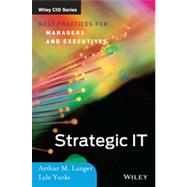
Note: Supplemental materials are not guaranteed with Rental or Used book purchases.
Purchase Benefits
Dr. ARTHUR M. LANGER is the Academic Director of the Executive Master of Science in Technology Management, Columbia University Program in Technology, School of Continuing Education. He also serves on the faculties of the Graduate School of Business and the Teachers College, Columbia University Graduate School of Education. He has authored seven books and writes for various technology journals and magazines.
Dr. LYLE YORKS is Associate Professor in the Department of Organization and Leadership, Teachers College, Columbia University, where he teaches graduate courses in strategy development. He serves on the Executive Education faculties at various universities, where he teaches classes in leading strategic change, negotiation, and organizational influence. He has presented on strategic influencing for the Chief Information Officer Institute workshops held at Columbia University.
Foreword
Preface
Acknowledgments
Chapter 1 The CIO Dilemma
Business Integration
Security
Data Analytics
Legal Exposure
Cost Containment
Some History
The Challenge
The New Paradigm
Consumerization of Technology: The Next Paradigm Shift
The End of Planning
The CIO in the Organizational Context
IT: A View from the CEO
Notes
Chapter 2 IT Drivers and Supporters
Drivers and Supporters
Drivers: A Closer Look from the CIO
Supporters: Managing with Efficiency
IT: A Driver or Supporter?
Technological Dynamism
Responsive Organizational Dynamism
IT Organization Communications with “Others”
Movement of Traditional IT Staff
Technology Business Cycle
Information Technology Roles and Responsibilities
Conclusion
Notes
Chapter 3 The Strategic Advocacy Mindset
What Is Strategic Advocacy?
A Political Economy Framework for Contextualizing Strategic Advocacy
Strategic Thinking: A Particular Kind of Mindset
Political Savvy as the Underpinning of Effective Strategic Advocacy
Conclusion
Notes
Chapter 4 Real World Case Studies
BP: Dana Deasy, Global CIO
Merck & Co: Chris Scalet, Senior Vice President and CIO
Covance: John Repko, CIO
Cushman & Wakefield: Craig Cuyar, CIO
Prudential: Barbara Koster, SVP and CIO
Procter & Gamble: Filippo Passerini, Group President and CIO
Cushman & Wakefield: A View from Another Perspective
Conclusion
Chapter 5 Patterns of a Strategically Effective CIO
Personal Attributes
Organizational Philosophy
Conclusion
Notes
Chapter 6 Lessons Learned and Best Practices
Five Pillars to CIO Success—Lessons Learned
The CIO or Chief IT Executive
Chief Executive Officer (CEO)
Middle Management
Conclusion
Notes
Chapter 7 Implications for Personal Development
Rationale for a Self-Directed Learning Process of Personal Development
Adopting a Developmental Action Inquiry Process for both Strategic Insight and Mindset Awareness
Testing One’s “Business” Acumen
Thinking Holistically in Terms of Situational Analysis and Synthesis of the Organization’s Position
Developing Strategic Mindsets within the Technology Function
The Balanced Scorecard
Conclusion
Notes
Chapter 8 The Non-IT CIO of the Future
Driver-side Responsibilities—New Automation
Conclusion
Notes
Chapter 9 Conclusions
Notes
Bibliography
About the Authors
Index
The New copy of this book will include any supplemental materials advertised. Please check the title of the book to determine if it should include any access cards, study guides, lab manuals, CDs, etc.
The Used, Rental and eBook copies of this book are not guaranteed to include any supplemental materials. Typically, only the book itself is included. This is true even if the title states it includes any access cards, study guides, lab manuals, CDs, etc.